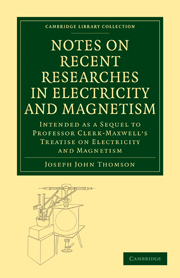 Notes on Recent Researches in Electricity and Magnetism
Notes on Recent Researches in Electricity and Magnetism Book contents
- Frontmatter
- PREFACE
- Contents
- CHAPTER I ELECTRIC DISPLACEMENT AND FARADAY TUBES OF FORCE
- CHAPTER II PASSAGE OF ELECTRICITY THROUGH GASES
- CHAPTER III CONJUGATE FUNCTIONS
- CHAPTER IV ELECTRICAL WAVES AND OSCILLATIONS
- CHAPTER V ELECTROMAGNETIC WAVES
- CHAPTER VI DISTRIBUTION OF RAPIDLY ALTERNATING CURRENTS
- CHAPTER VII ELECTROMOTIVE INTENSITY IN MOVING BODIES
- APPENDIX: The Electrolysis of Steam
- INDEX
CHAPTER I - ELECTRIC DISPLACEMENT AND FARADAY TUBES OF FORCE
Published online by Cambridge University Press: 05 August 2011
- Frontmatter
- PREFACE
- Contents
- CHAPTER I ELECTRIC DISPLACEMENT AND FARADAY TUBES OF FORCE
- CHAPTER II PASSAGE OF ELECTRICITY THROUGH GASES
- CHAPTER III CONJUGATE FUNCTIONS
- CHAPTER IV ELECTRICAL WAVES AND OSCILLATIONS
- CHAPTER V ELECTROMAGNETIC WAVES
- CHAPTER VI DISTRIBUTION OF RAPIDLY ALTERNATING CURRENTS
- CHAPTER VII ELECTROMOTIVE INTENSITY IN MOVING BODIES
- APPENDIX: The Electrolysis of Steam
- INDEX
Summary
1.] The influence which the notation and ideas of the fluid theory of electricity have ever since their introduction exerted over the science of Electricity and Magnetism, is a striking illustration of the benefits conferred upon this science by a concrete representation or ‘construibar vorstellung’ of the symbols, which in the Mathematical Theory of Electricity define the state of the electric field. Indeed the services which the old fluid theory has rendered to Electricity by providing a language in which the facts of the science can be clearly and briefly expressed can hardly be over-rated. A descriptive theory of this kind does more than serve as a vehicle for the clear expression of well-known results, it often renders important services by suggesting the possibility of the existence of new phenomena.
The descriptive hypothesis, that of displacement in a dielectric, used by Maxwell to illustrate his mathematical theory, seems to have been found by many readers neither so simple nor so easy of comprehension as the old fluid theory; indeed this seems to have been one of the chief reasons why his views did not sooner meet with the general acceptance they have since received. As many students find the conception of ‘displacement’ difficult, I venture to give an alternative method of regarding the processes occurring in the electric field, which I have often found useful and which is, from a mathematical point of view, equivalent to Maxwell's Theory.
- Type
- Chapter
- Information
- Notes on Recent Researches in Electricity and MagnetismIntended as a Sequel to Professor Clerk-Maxwell's Treatise on Electricity and Magnetism, pp. 1 - 52Publisher: Cambridge University PressPrint publication year: 2010First published in: 1893


